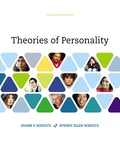
To discuss:
Influence of Horney’s childhood experiences in her theory.
Introduction:
Lack of adequate love in childhood might lead to hostility and anxiety in the future. At the age of adolescence, unhealthy relationship with the opposite sex might get developed due to longing for love from the opposite sex of parenthood.
Explanation of Solution
Horney believed childhood emphasis mainly on the security required for them which protects them from fear and lack of this security from parents might induce hostility. This can be due to the obvious preference given by parents to other siblings, humiliation. The children could easily found out whether the love expressed to them are genuine. At her childhood, Horney was longing for love from her parents which lead her to exhibit rebellion behavior and induces hostility. She always believed her brother is important for her parents. Her lack of physical confidence made her decide to challenge the world intellectually.
Thus her childhood experiences play a significant role in her personality theory.
Want to see more full solutions like this?
Chapter 5 Solutions
EBK THEORIES OF PERSONALITY
- what is it like to be in the Dharma center of worship massachusetts? what was the most interesting thing?how does this place help your better understanding of religious practices?arrow_forwardDescribe the interior decoration in detail of the dharma center in Cambridge massachusetts.arrow_forwardCan you help me find 20 research peer review article on psychology evolutinary&cultural that has do with indiaarrow_forward
- Can you help me find 20 peer review article on psychology evolutinary&cultural that has do with indiaarrow_forwardIntroduction: An open question is a question that cannot be answered 'yes or no. Instructions: As you relate to the content for this week of Jazz, think of an open question you could ask yourself and try to elaborate a brief open response in 150 words. Your question can relate to anything about jazz, directly or indirectly.arrow_forwardIntroduction: An open question is a question that cannot be answered 'yes or no. Instructions: As you relate to the content for this week, A History of Jazz, think of an open question you could ask yourself and try to elaborate a brief open response in 150 words. Your question can relate to anything about jazz, directly or indirectly.arrow_forward
- can you make me a a spps box plot that has all the data 1- through 67 that has age,ethencity, person 2 is person attractive with tattoss and queston 13 is attractive without tattoosarrow_forwardI need you to make a box plot on SPSS using age, ethnicity, person 2 is people attractive with tatoos an person 13 is people attractive without tattosarrow_forwardCan you help me find 20 peer review article on psychology evolutinary&culturalarrow_forward
- Does this article have to do with evolutionary psychology & cultural https://www.cambridge.org/core/journals/ageing-and-society/article/views-and-experiences-of-adult-children-concerning-intergenerational-relationships-with-their-older-kin-a-qualitative-study-from-south-india/F71A9BA3F3FB27D16CE589E8885CFB53arrow_forwardWhat should the role of a school counselor be as it applies to Section 504 of the Rehabilitation Act of 1973? Write in a narrative format and include in the in-text citations of the following source: “American School Counselor Association. (2024). The school counselor and Section 504 plan and process. https://www.schoolcounselor.org/Standards-Positions/Position-Statements/ASCA-Position-Statements/The-School-Counselor-and-Section-504-Plan-and-Proc “arrow_forwardWhat role do you think social media has on the occurrence of domestic violencearrow_forward
 Ciccarelli: Psychology_5 (5th Edition)PsychologyISBN:9780134477961Author:Saundra K. Ciccarelli, J. Noland WhitePublisher:PEARSON
Ciccarelli: Psychology_5 (5th Edition)PsychologyISBN:9780134477961Author:Saundra K. Ciccarelli, J. Noland WhitePublisher:PEARSON Cognitive PsychologyPsychologyISBN:9781337408271Author:Goldstein, E. Bruce.Publisher:Cengage Learning,
Cognitive PsychologyPsychologyISBN:9781337408271Author:Goldstein, E. Bruce.Publisher:Cengage Learning, Introduction to Psychology: Gateways to Mind and ...PsychologyISBN:9781337565691Author:Dennis Coon, John O. Mitterer, Tanya S. MartiniPublisher:Cengage Learning
Introduction to Psychology: Gateways to Mind and ...PsychologyISBN:9781337565691Author:Dennis Coon, John O. Mitterer, Tanya S. MartiniPublisher:Cengage Learning Psychology in Your Life (Second Edition)PsychologyISBN:9780393265156Author:Sarah Grison, Michael GazzanigaPublisher:W. W. Norton & Company
Psychology in Your Life (Second Edition)PsychologyISBN:9780393265156Author:Sarah Grison, Michael GazzanigaPublisher:W. W. Norton & Company Cognitive Psychology: Connecting Mind, Research a...PsychologyISBN:9781285763880Author:E. Bruce GoldsteinPublisher:Cengage Learning
Cognitive Psychology: Connecting Mind, Research a...PsychologyISBN:9781285763880Author:E. Bruce GoldsteinPublisher:Cengage Learning Theories of Personality (MindTap Course List)PsychologyISBN:9781305652958Author:Duane P. Schultz, Sydney Ellen SchultzPublisher:Cengage Learning
Theories of Personality (MindTap Course List)PsychologyISBN:9781305652958Author:Duane P. Schultz, Sydney Ellen SchultzPublisher:Cengage Learning





